by Bok-Nam Park and Glen Moore
[Adapted and re-edited by F. Hriadil]
Throughout many of the dynasties in China, tales and legends have been told about Taoism that involve balance in nature, mysticism, and immortality. Among some of the most popular stories that have been told are those about the Ba Shen or “Eight Immortals.” Stories about the Eight Immortals have influenced China’s philosophy, religion, and martial arts for centuries. Many such tales are still as popular today as they were hundreds of years ago. Gift shops throughout all of the Chinatowns in the United States sell paintings, ink drawings, carvings, statues, and figures carved in jade, ivory, or exotic woods that portray the Eight Immortals.
The “Immortals” were often portrayed in stories as mystics who interceded themselves into the everyday lives of mortals to teach and/or demonstrate the ways of Taoism. This was sometimes done with great humor or mischief, but generally always with compassion for the suffering of the oppressed. In this article, we are going to present a poem about the Eight Immortals which was written in relation to the Ba Gua Jian (Straight Double-edged Sword) and its use in Ba Gua Zhang.
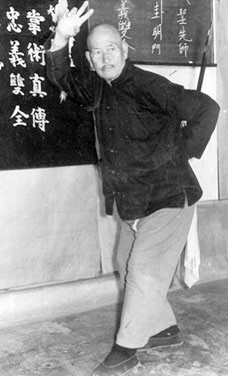
Please do not judge my translation of the poem too harshly as it was very difficult to render a good representation of the true meaning in English and still capture what the author was trying to convey.
The poem is entitled Eight Immortals Sword. It implies that a sword form called Ba Gua Ba Shen Jian (Ba Gua Eight Immortals Sword) was created in recognition of the Eight Immortals – utilizing each Immortal’s special skills, traits, and characteristics. Each line of the poem addresses something about one of the individual Eight Immortals and their contribution to the Eight Immortals Sword. The poem, in Chinese and English, is as follows:

“Eight Immortals” Sword
= = =.
Iron Cane Li (Li Tie Guai) possessed supreme swordsmanship.
Guo Lao (Zhang Guo Lao) not only can split sawgrass flowerettes, but can
slice the Phoenix’s feather with his sword.
Dong Bin (Lu Dong Bin) carries his sword on his back and chooses to live
a life of moderation.
Zhong Li (Zhong Li Chuan) demonstrates the best martial arts stance and form.
Guo Jiu (Cao Guo Jiu) is feared greatly by both ghost and goddess wherever he goes.
Cai Ho (Lan Cai Ho) spreads four gates and her sword shines through.
Xian Gu (Ho Xian Gu) is the best a setting the Ba Gua pattern.
No one can survive Xiang Zi’s (Xiao Xiang Zi) soul chasing sword.
What follows is the translation, presented line by line, along with some of the explanation provided to me by Lu Shui-Tian about the significance and meaning of the words.
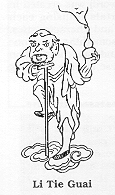
Iron Can Li (Li Tie Guai) possessed the supreme swordsmanship
This Immortal was named Li Tie Guai and referred to as “Iron Cane” Li because of the iron crutch that he carried. Li is always depicted as a beggar with a crutch. The story is told that he had attained such a high level of magic skill that he was often called from Earth to the Celestial Heavens to perform his magic. When Li traveled to the celestial regions, he traveled only in spirit, leaving his body on Earth in the charge of one of his disciples. On one occasion, Li was gone longer than usual and the disciple thought that Li had actually died. So, he burned his body. When Li returned to Earth and found that his body was gone, he looked for the body of a recently deceased individual to enter. The only body he could find was the body of a lame beggar. Li entered this body and thus is always depicted as a beggar with an iron crutch. He also carries a pilgrim’s gourd and he is sometimes shown standing with a deer or standing on a crab.
It was said that Li Tie Guai possessed the supreme swordsmanship but most often appeared poor, down trodden, and acted like a clown – not having a care in the world. Lu Shui-Tian said that Li’s contribution to the Eight Immortals Sword was strategy because he appeared as a clown and beggar yet possessed the highest sword skill of all of the Eight Immortals.
The Eight Immortals Sword is simple, yet elegant. You will not find any gymnastics here. You will find that movements are very efficient and effective. Just like the old Taoist saying, “The sage is always quietest before he strikes.” Lu Shui-Tian also said that, since Iron Cane Li acted like a clown, carefree and uninhibited, he exhibited the Taoist characteristic of living without stress. Stress, that we create by being too serious about mundane everyday life, can disrupt our Qi.

Guo Lao (Zhang Guo Lao) not only can split sawgrass flowerettes, but can slice the Phoenix feather with his sword.
Zhang Guo Lao was a recluse who had supernatural powers. He could turn himself invisible. When summoned to serve in the Emperor’s court, he replied that he preferred the wandering life of a hermit. It is said that he traveled backwards on a white mule and thus is often depicted riding a mule in this manner. His emblem is a bamboo instrument that is struck with two rods.
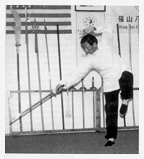
This line of the poem describes the extreme precision with which the sword is wielded. Although the Eight Immortals Sword has many different movements, most are accomplished with articulations of the wrist or small precise movements of the arm that emanate from the body. These small motions add great speed and precision to the movements of the sword. The high degree of precision described by this line of the poem can be easily understood if you have ever seen sawgrass flowerettes, which are tiny delicate flowers that appear on the sawgrass. It would take a deft hand indeed to cleave such a tiny delicate thing. Lu Shui-Tian always emphasized precision in movement when he demonstrated his sword skills. And, he had me practice many hours of repetitive drills which involved striking small balls, bamboo reeds, or string – in order to improve my precision with the sword.

Dong Bin (Lu Dong Bin) carries his sword on his back and
chooses to live a life of moderation.
Lu Dong Bin was a scholar who studied Taoism with Zhong Li Chuan, the Chief of the Eight Immortals. Lu is usually depicted holding a Taoist flybrush in this right hand and has a sword slung over his back. It is said that he was given a series of ten temptations to overcome in order to demonstrate his purity and virtue. Having overcome all ten temptations, Lu was given a supernatural sword. He used this sword to slay dragons and demons – ridding the world of evil. Lu Dong Bin’s sword was named Chan-yao Kuai, which loosely translated means “Devil Slayer.”
Carrying the sword on his back and living in moderation meant that he was always vigilant in not straying from the middle path. Always using the sword to cleave away any temptations to stray, Lu stayed true to his path – even when presented with the ten most difficult temptations. In the Eight Immortals Sword, this means that there are no excesses or insufficiencies and every technique adheres to the middle or balanced path.
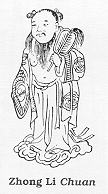
Zhong Li (Zhong Li Chuan) demonstrated the best
martial art stance and form.
Zhong Li Chuan was the Chief of the Eight Immortals. He is usually depicted as a fat man holding a fan. Sometimes he also holds peach.
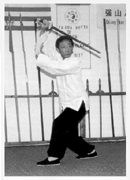
Lu Shui-Tian said this line of the poem illustrates that any technique, no matter whether it uses empty hand or weapons, has to have good footwork. This is especially true in Ba Gua Zhang as the same footwork is used for both empty hand and weapons methods. Lu went on to explain how the correct footwork places the practitioner in a position of advantage and protects him from counter techniques. In order for this to happen, all footwork must meet the required prinicples and theories of the Ba Gua Trinity:Yin & Yang, the Wu Xing (Five Elements), and Ba Gua (from the Yi Jing). Lu Shui-Tian also said that even though footwork was extremely important, it must be in balance with the body and the mind so that no extreme existed – then everything would be in balance or moderation.

Guo Jiu (Cao Guo Jiu) is feared greatly by both ghost and goddess wherever he goes.
Cao Guo Jiu was not a popular Immortal because he was so fierce. It was said that he was a member of the imperial court and was a very dangerous person to tangle with. He was the son of a military commander and brother of the Empress Cao Hou of the Sung Dynasty. His symbol is a pair of wooden castanets which were made from the court tablet. Many people believed that he was elevated to the level of Immortal only because the other seven thought that he would prove useful.
Lu Shui-Tian felt that this line of the poem has two implications. First, don’t waste time with things that are not useful. He felt this line illustrated that none of the movements in the the Eight Immortals Sword were put there just for beauty or elegance. Everything put there was useful for combat. Second, he felt that Cao’s fierceness showed that the sword must not be performed without intent, as many forms are unforturnately executed today. Lu Shui-Tian felt that without intent, Qi will not flow properly nor will the sword movements be correct. Without proper intent, the sword will appear dead or lifeless. He always referred to a form that was done with the proper rhythm and intent as “bright” or “living” and a form that did not exhibit these traits as “dark” or “dead.” He also made reference to the eyes in most instances when he was referring to intent.
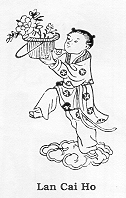
Cai Ho (Lan Cai Ho) spreads four gates and her sword shines through.
Lan Cai Ho’s emblem is a flower basket. This particular Immortal is sometimes depicted as a female and sometimes as a male. As such, he or she (as you may choose) represents change and is the representation of Yin and Yang within the Eight Immortals Sword. In this character, we also find a representation of unpredictability that is always present with a lunatic, or one who may be referred to as “touched by the Gods.”
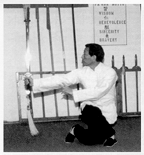
The reference to the “four gates” in this line of the poem refers to a particular type of sword entry into the space of an opponent which, with quick wrist maneuvers, renders damage, or as the line states “shines through.”
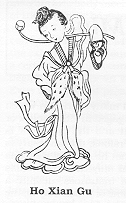
Xian Gu (Ho Xian Gu) is the best at setting the Ba Gua pattern.
Ho Xian Gu is the only true woman of the group and is perceived as being very wise and a good organizer. Having eaten a supernatural peach, she became a fairy wondering the hills. It is said that once she was in danger of being overcome by a demon, but Lu Dong Bin saved her using his magic sword.

It is thought that she is the one who pulled the other Immortals together to create the Eight Immortals Sword and that she herself was chosen to set the pattern for the form. Every form has a particular pattern. And, as Lu Shui-Tian said many times, without rhythm, a form is “dead.” The organization skills of Ho Xian Gu remind us to adhere to natural patterns and rhythms in martial arts practice.
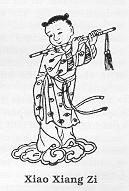
No one can survive Xiang Zi’s (Xiao Xiang Zi) soul chasing sword.
Xiao Xiang Zi was the son of a famous scholar and it is believed that he could make flowers grow and blossom instantly. He was student of Lu Dong Bin, who took him to the supernatural peach tree to become Immortal. His emblem is the flute and he is the patron saint of musicians. It is said that whenever he was given money, he scattered it about on the ground because he had no need for it. Xiao Xiang Zi is depicted as very young and it is said that he did not like to utilize his sword. But when he did use his sword, no one could escape. It is also said that Xiao traveled the countryside playing his flute and attracting birds and beasts of prey with the beautiful sound.
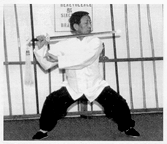
This line in the poem sets the tone for the use of the weapon. It should only be used in extreme cases but when it becomes necessary, it should be wielded with authority. Xiao Xiang Zi is depicted many times carrying a flute and one of the techniques in the Eight Immortals Sword resembles someone playing a flute. Lu Shui-Tian also said this meant that we should try to live in balance and harmony but when things are interfering with that harmony, we should not hesitate to cut them out – or balance them. Given the right discipline, we should never fail to set things just as Xiao Xiang Zi did and, metaphorically, cut them out.
Lu Shui-Tian explained to me that the Jian (Straight Sword) is not for use by a beginner in the internal martial arts. He said that of all of the Ba Gua weapons, the Jian, in particular, required a meticulous foundation of the body, the footwork, and the mind before one could hope to master its methods. The Jian is considered a very high level weapon, meaning that it requires a great deal of skill to wield properly. It requires wrist, shoulder, and waist training along with proper utilization of whipping body principles to make the weapon effective. Many times I have gone to tournaments and seen people perform with the Jian. It was extremely rare that I was rewarded with a pleasant sight. Most of the people who were attempting to perform the Jian were really beginners. Their forms were lifeless. I use the term “lifeless” here figuratively, but it could be taken literally because the practitioners that I saw would have cut themselves to ribbons with a real sword. It was clear from their performance that they did not understand that the Jian is a double-edged weapon. I hope that in the future, we will see people utilizing this weapon with proper technique, proper intent, and with a properly prepared body.
The Jian is a wonderful weapon and the Eight Immortals Sword is a wonderful form. In my “style” of Ba Gua Zhang, the training is long and rigorous and there are many basic sword techniques to practice before the Eight Immortals Sword will be taught. After my students complete this form, they will not just know a “form;” they will also understand the many uses and applications of its movements. I know that no one will walk down the street today carrying a Jian in preparation for a fight, but it is necessary to understand intent and use in order for the Qi to flow properly. This means that the practice of the Eight Immortals Sword must be “bright” and have the proper rhythm.
This has been a very brief introduction to the Jian as a Ba Gua weapon. I hope it has been educational and entertaining. I fully believe that the internal arts offer a better life for all who practice them. It is my hope to share as much knowledge as possible so that Ba Gua Zhang does not become a watered down or lost art as so many others have.
Above is an adaptation and re-editing of an article that first appeared in the “PA KUA CHANG JOURNAL,” Volume 6, No. 2, Jan/Feb 1996, which was published by High View Publications. The “Journal” is no longer being published and back issues may no longer be available
